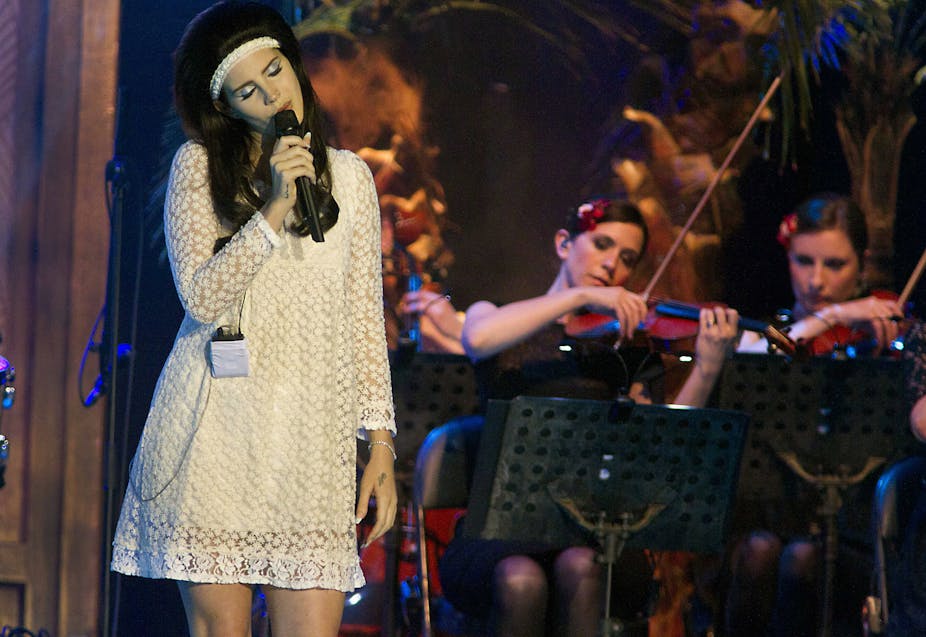Lana Del Rey is so boring. The most interesting thing about her is the gorgeous, Prell-girl hair that frames her expressionless face in videos and photographs. In interviews, she likes to complain about how the media misunderstands her. She smokes. She calls her music “Hollywood sadcore” and “narco swing”. She admits she’s slept around, a lot, sometimes with strangers. She’s made a lot of stupid statements about feminism, but at least has the tact (I’m looking at you, Miley) to acknowledge that she neither knows much about it nor cares to discuss it. And, most controversially (stifles yawn) — she likes to talk about how she wishes she were dead.
First she said it, and then tried to deny it. Francis Bean Cobain, daughter of late Nirvana frontman Kurt Cobain, took to Twitter to throw shade at Lana Del Rey for romanticising death (although the tweet has since been removed). Yet when asked about the issue again, this time in Rolling Stone, Del Rey said: “I find that most people I meet figure I kind of want to kill myself anyway.” Kind of. But she was more interested, in the Rolling Stone interview, in lamenting her unfitness as cover story material.
So why the flap over this particular young woman, and not, for example, Lady Gaga who staged her own death by paparazzi at the 2009 VMAs? After all, Kurt Cobain put a gun on the proverbial mantelpiece of every song on Nirvana’s Nevermind album, and Amy Winehouse practically died before our eyes.
But this is just it. It’s the extreme banality with which she approaches the topic that seems to have shocked everyone. She’s tapping into a very old trope – that of the sleeping beauty, an idea that very quickly mutates into the beautiful corpse. At the same time, she’s making death not an accident or tragedy, but something she just, well, kinda sorta thinks would be cool.
It is the latter stance which sparks the controversy, because it refuses to partake in the kind of economy of meaning that converts celebrity death into heightened relevancy and increased sales. Perhaps in just her very boring-ness, then, Del Rey is rather subversive.

Representations of death very often take the form of young women. Take the 19th century painting The Anatomist. There’s a skull on one side of the young woman whom the anatomist is about to dissect. Next to the skull are his books and manuscripts. This body is at once at the centre of the production of knowledge, and inert, beautiful, nude. Science and sex merge. The anatomist is shown lifting the corner of her shroud to view her naked breast – for science. She is in some ways the ideal woman: silent, compliant, and yielding of her many secrets.
In the videos of her songs Blue Jeans and Born to Die, and to a lesser extent Young and Beautiful, Lana Del Rey’s image is very much that of the beautiful corpse. She wears white in all three videos. Her face is expressionless and, in the first two videos, inert. In these two, the man who caresses her limp body is covered in tattoos — words and meaning are inscribed on him and are his to control, while she is a blank slate. This imagery is as old as Snow White, and just about as controversial.
Del Rey undermines the passivity of these images by claiming that this is something she wishes for, as one might wish for fair weather or an easy commute. She doesn’t say she wants to die or that she plans to kill herself — the quote is “I wish I were dead already”. In a culture hungry for more tragically beautiful dead bodies, that’s rather subversive: it denies the tragedy.
Our contemporary notion of how death works is a comparatively modern thing – our main concern is the management of life. Our society works to promote and provide life, rather than governing with the threat of death. We vaccinate, we hospitalise, we manage our populations. Gone are the days of the public execution, a sentence handed down from a king with a God-given birthright. In those days, death was a continuation of this hierarchical society, where one exchanged an earthly king for a celestial one. Today, death has become a no-man’s land, where the concerns of the living cannot reach.
But we have no congress with the dead, and we have no exchange with them. They are elsewhere – unless they happen to be famous. Then their images circulate here on earth with even greater value. Take Michael Jackson, who appeared posthumously in Las Vegas as a hologram and who, in the five years since his death, has made more money for his estate than in the ten years previous. Or perhaps more poignantly, consider that in the US one can purchase a prepaid Mastercard with the image of James Dean on it.
Lana Del Rey isn’t contemplating suicide. She’s just sort of commenting that death might be sorta nice. In doing so, she flies in the face of the idea of death as exile. In her videos, Del Rey is already dead, perhaps, choosing to circulate as a corpse. It is this sense of choice that is the difference. If her beautiful corpse is going to appear on a prepaid credit card, it will happen while she’s still alive to reap the benefits. That kind of audacity flies in the face of the cult of celebrity tragedy that Cobain, Winehouse and others have built. This is why it is outrageous.

